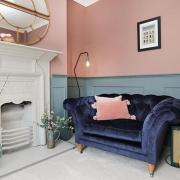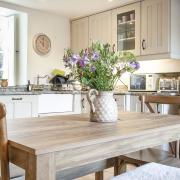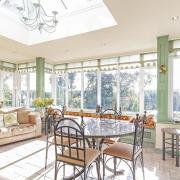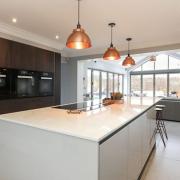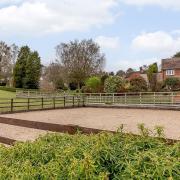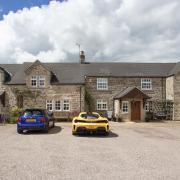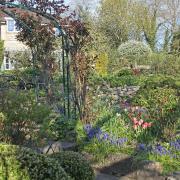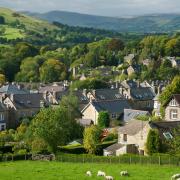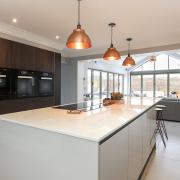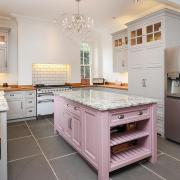Simon Turton visits Harthill and Lea Hall, two historic county properties that have been given a new lease of life by entrepreneur Nicola Bunting
For visitors to Derbyshire, and perhaps also for many of us who live in this diverse and beautiful county, there are many historic houses open to the public that come to mind when planning a day out. They range from world famous Chatsworth to other popular historic estates such as (in no particular order) Eyam, Hardwick, Haddon, Kedleston, Tissington and Sudbury Halls, Calke Abbey and Bolsover Castle. These properties are all fantastic examples of living history, several of which are still used as family homes where their unique stories are still unfolding.
However, if we do a little digging there are numerous other historic halls and manor houses across the county that are either private residences or operate as hotels and/or spas. There are no brown signs to let us know where these hidden gems are; even Hassop Hall, which is a grand hotel and restaurant, is a place you wouldn’t necessarily stumble across unless you knew it was there.
The same goes for Harthill Hall at Alport, near Bakewell, and Lea Hall at Lea, near Cromford, two little known properties that are every bit as fascinating as the better known piles.
Harthill Hall, which dates back to the time of the Crusades, first caught the eye of Nicola Bunting and her husband, Peter in 1996 when they were looking for a property suitable for their young family. At the time they were living in Cheshire and were considering a move to London but when Harthill Hall came up for sale, and after just one visit, they were in little doubt that this would become their new home.
As Nicola explains: ‘As you approach the property the view of the manor house is eclipsed by a row of buildings, but the view of the roofline of the manor house alone immediately captured our imagination.’ They had moved in within a matter of weeks.
Nicola soon discovered that purchasing the property had been the easy part. They had inherited a formica and linoleum interior that dated back to the 1960s, with a colourful design scheme straight out of the psychedelic sixties. Almost every original internal feature had been covered up and hidden, a trend that swept the country; covering up and hiding what had gone before an understandable reaction against the austere post-war years.
Nicola’s approach to restoring the manor house was to take the building back to its original state wherever possible – essentially turning the clock back a few hundred years. Never having been involved in such a complex refurbishment programme before, she immersed herself in traditional building methods and period design and architectural styles. Then once the refurbishment of the manor house was underway, she turned her attention to upgrading the eight self-catering cottages created by the previous owner.
One, named ‘The Chapel’ and in part of the original medieval hall house required particularly sensitive treatment. Records show that a chapel had been added to thehouse by 1259 and a papal bull issued sanctioning its use as a place of Catholic worship; it was also at one time a court house. The other seven cottages, in converted barns and stables, were also given names that relate to the history of the estate. Nicola drew up interior schemes to create individually-styled cottages sympathetic to their heritage. She selected period furniture and original paintings to complement the refurbishment scheme, which even included installing hot-tubs on the cottages’ private verandahs with stunning views across the estate and the surrounding open countryside.
A carefully phased programme of work meant that most of the cottages remained in use while others were worked on, until all eight emerged transformed. A heated indoor swimming pool was totally stripped out and re-lined and spa treatment rooms added for the exclusive use of guests. An adjacent listed barn was transformed into a two-storey barn conversion with the kitchen and sitting room on the first floor to better enjoy the spectacular views.
Working with such an old property required patience and perseverance as the hidden secrets of the original buildings were uncovered. In the manor house’s kitchen a layer of asphalt had been laid on top of original flagstones. These were painstakingly uncovered and now again grace the hub of the property. At the front of the manor house the original double-transom window was restored, giving a view over the delightful reinstated 16th century knot garden. Throughout the property leaded lights were replaced.
Although Nicola was extremely busy restoring the interiors of manor house and cottages, the extensive grounds – around 15 acres – weren’t ignored. A man�ge, paddock and stabling were refurbished, and two existing summer houses were restored to be used as games rooms. Drives were re-laid, new fences erected, dry stone walls repaired and meadows were tamed.
During the renovation of Harthill, Nicola and Peter also purchased and refurbished The Old Angel, a former coaching inn in Winster, which is now part of Nicola’s portfolio of period self-catering holiday properties.
By 2006 – after completing their 10-year restoration project – rather than sit back and enjoy the fruits of their labour, the Buntings were on the look-out for a new challenge. In 2008 they came across Lea Hall – a grade II* listed property – located just to the north of the delightful village of Lea.
Lea Hall was the childhood home of Florence Nightingale, before her family moved to Lea Hurst in the same village. The hall was owned by Florence’s grandfather, Peter Nightingale, who went into business with John Smedley in 1784, producing muslin and spinning cotton. Smedley eventually took over the running of the business, although the Nightingales retained an interest in the company. Today, John Smedley is internationally-acclaimed and still manufactures on the original (albeit extended) site.
While Harthill Hall is a fine example of an early manor house it is undoubtedly understated. By comparison Lea Hall is a flamboyant upstart. Its Georgian fa�ade, added in 1754, virtually doubled the size of the original manor house.
Lea Hall was exactly what Nicola had been looking for, as she says: ‘We were looking for an unrestored property that we could stamp our style on. During our search we saw that many fine houses and period properties had been fitted with plastic windows, which meant that they were immediately off our list. If an owner had specified plastic windows then the interior would have been similarly modernised in styles that all too often undermined the integrity of the original property. Lea Hall needed very little of anything uncovering as it had not fallen victim to the 1960s syndrome, but it did need a lot of work.’
Having gained experience in period design and architecture Nicola moved very quickly through the 10-bedroomed property. The objective for Lea Hall, as with Harthill, was to create an authentic and beautiful self-catering property, with the intention of offering the best experience for visitors to Derbyshire – a confident objective given the number of high quality self-catering properties across the county.
Nicola drew up her plans – in liaison with English Heritage – appointed contractors and project managed the entire refurbishment programme. The gardens were restored, which involved removing hundreds of tonnes of earth that had been dumped on the rear south-facing courtyard by a succession of previous owners. With the soil removed, Nicola reinstated a Yorkshire stone patio and a terraced formal garden which is bisected by stone steps leading to a remodelled trout pond and refurbished tennis court.
At the Georgian front of the property, steps up to the main entrance and cellar windows were repaired and, following the removal of many more tonnes of earth, a large flagged terrace was discovered and reinstated. Walls were rebuilt, driveways resurfaced and the walled vegetable garden brought back into productive use.
Whereas Harthill Hall took over ten years to complete, Lea Hall’s transformation has taken just 18 months, a testimony to the hard work and dedication of the Buntings who have been involved in every aspect of the restoration programme.
Lea Hall and Harthill Hall have been given a new lease of life as self-catering properties but unlike many other such properties you can have Harthill Hall’s manor house or Lea Hall to yourself. Available for a holiday, short break or wedding celebration, once you arrive you feel as if you have entered another era, a genteel and aristocratic world away from the trappings of modern life. You can even ‘live the dream’ by calling on the services of award-winning Chequers Outside Caterers who can either supply a chef and staff to look after your every gastronomic need or provide a range of pre-cooked meals for you to re-heat.
The fact that reservations have been taken for holidays well into 2011 is a testimony to Nicola’s hard work. When asked if another property is on the cards, her response gives little away: ‘Having spent 13 years renovating three period properties there are no immediate plans to increase our portfolio, but if the right restoration project becomes available then my view is never say never – unless, of course, white plastic windows are involved.’
For more information contact Nicola Bunting at Derbyshire Country Houses.
Tel: 01629 636190enquiries@derbyshirecountryhouses.com





